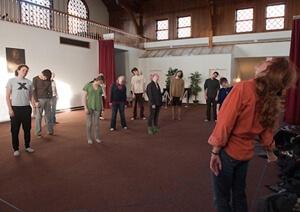The sixteen students in the University of Vermont's Integrated Fine Arts (IFA) Program are sitting stiffly at drafting tables arranged in a circle in a high-ceilinged art studio, setting out charcoal, erasers and pencils in preparation for a two-hour life drawing class. At 8:30 a.m., it's their first class of the day, and Professor Lynda McIntyre walks around the room, studying the tired-looking group.
With auburn hair illuminated in the morning light, McIntyre greets the model and the students, most of whom have never studied drawing. Then, struck with an idea, she tells the students to put down their charcoal and jump off their stools. "Move, stretch," she exhorts.
Soon the first-year students are hopping and whirling and rolling their arms through the air without an ounce of self-consciousness. They've done this before: earlier in the semester, McIntyre guided them to create dance sequences using their bodies in dynamic movements. McIntyre encourages them to use that feeling of freedom to capture the curving and twisting poses held by the model, who shifts her body every two minutes.
"Now draw from the shoulder," McIntyre advises the class. Noticeably more relaxed, the students settle back onto their stools.
A studio art professor, McIntyre is pushing the students to comprehend the connections between motion, gestures and form. As they work on their sketches, McIntyre reminds them that next week's class will return to learning salsa dancing, while that afternoon they'll take part in a workshop with Momix, a dance group performing at the Flynn Theater that week.
The IFA program, in its inaugural year, aspires to nurture a group of artistic leaders at UVM, says Alexander Stewart, a music professor and the program's director. "We're hoping to take a group of students who come in with a skill in one or two directions, and challenge them by having them work in disciplines other than the ones they're most comfortable in," he says. He stresses that by introducing them to fields outside their comfort zone, they'll be able to bring insights and new ways of thinking back to their own disciplines.
While it may seem obvious that many art forms - think opera - combine several artistic trades, disciplines tend to be taught separately in schools and universities. Music students, for example, stick to their practice rooms and theory classes, while studio artists rarely venture into dance studios.
The Integrated Fine Arts program instead is taking an almost backward approach, Stewart points out. Rather than starting by honing the basic tools of a specific skill, the program stresses a comprehensive understanding of the arts, ranging from creative writing to avant-garde music.
And just as importantly, the program includes a residential element, with the sixteen students living together on a floor at the Living/Learning Center. For first-years, being able to connect with like-minded students builds an instant social network.
Artists in residence
Wes Devore, a music major and composer, says the residential component attracted him after Stewart reached out to him to encourage him to apply for the IFA program. "I really liked the idea of living with other people with similar interests," he says. "Everyone here just clicked really well," he adds. "More so than if we had a normal dorm."
Having the students work and live together benefits their studies and cohesiveness, Stewart explains. He was surprised when, for the first lecture of his avant-garde music class, all 16 students arrived at once. "I asked, 'Did you ride over on the bus together?' and they said, 'Oh no, we just walked over together from our rooms.' I've noticed every class is like that. Right away that was so different."
It dawned on Stewart that the group would be able to collaborate on projects easily, which has influenced his approach. One assignment asked the students to create a percussion piece using items in their dorm, and several classes were held at Living/Learning as they performed their pieces. "The assignment was to write specific instructions so that anyone could play it," he says. Most were written for several of their peers to perform. And the objects they used? "You name it - a microwave, a bicycle, pots and pans and dishes, water bottles, a fan."
The program itself was created through connections, with McIntyre, Stewart, and several other arts professors brainstorming about the theme the program would embody. Ideas were thrown out, ranging from the Harlem Renaissance to political expression in the arts. But then they hit upon experimentalism and breaking the boundaries between music, movement, fine arts, writing and film. Each semester, the IFA students take two classes created for the program. After Stewart's music class and McIntyre's arts-collaboration seminar this fall, the students will move onto creative writing and film in the spring.
Back in the studio, McIntyre asks the students to take a moment to think about their progress.
"What changes have you seen in your own style?" poses McIntyre. To Michael Wandell, a bearded and lanky first-year who came to the program with a music focus, she asks, "Is this you a week ago?" He looks at his sketch and, with surprise in his voice, replies "No." Later, he admits that he had always felt "handicapped" when it came to drawing. "It's been really cool," he adds.
The integrated approach "probably makes you a more creative thinker," McIntyre says later in her office. "Learning different languages helps people enjoy their lives more and become more compassionate about different ways of seeing."

Integrated Arts Program Breaks Boundaries in Its Inaugural Year
ShareNovember 12, 2009